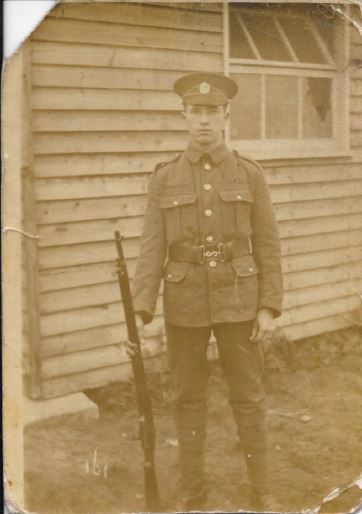Pte
Sidney Alfred Roberts
Information about birth
|
Date of birth: 07/03/1897 |
|
Place of birth: Upper Gornal, Staffordshire, England, United Kingdom |
General information
|
Profession: Coal miner |
Army information
|
Country: England, United Kingdom |
|
Force: British Expeditionary Force |
|
Rank: Private |
|
Service number: 242521 |
|
Enlistment place: Rotherham, Yorkshire, England, United Kingdom |
|
Units: — York & Lancaster Regiment, 1/5th Bn. (Last known unit) |
Information about death
|
Date of death: 09/10/1917 |
|
Place of death: Marsh Bottom, Passchendaele, Belgium |
|
Cause of death: Killed in action (K.I.A.) |
|
Age: 20 |
Memorial
|
Tyne Cot Memorial Panel: 127A |
Distinctions and medals 2
|
British War Medal Medal |
|
Victory Medal Medal |
Points of interest 3
| #1 | Place of birth | ||
| #2 | Enlistment place | ||
| #3 | Place of death (approximate) |
My story
Sidney Alfred Roberts was the son of Ada Annie and Henry Roberts. He was born on 7 March 1897 in Upper Gornal, Staffordshire. Sidney worked as a coal miner. He enlisted at Rotherham, Yorkshire and joined the 1/5th Battalion York & Lancaster Regiment (148th Brigade, 49th (West Riding) Division).
Sidney Alfred Roberts was killed on 9 October 1917 at the Battle of Poelkapelle, part of the Battle of Passchendaele. On that day, the 148th Brigade attacked at 5.20am, zero hour, with the 1/4th and 1/5th York & Lancaster Regiments and the 5th King's Own Yorkshire Light Infantry and the 4th King's Own Yorkshire Light Infantry in reserve. The brigade advanced with the 1/4th Hallamshires on the right and the 1/5th and 5th Yorkshires on the left from their positions at Waterloo and Berlin Wood.
At 5.20am the barrage opened and the brigade moved forward. The Ravebeek was the first serious obstacle. Previous shelling had caused the brook to burst its banks so that the small stream had now become a large swamp some 30 to 50 metres wide. This forced most of the brigade to move to the Meetcheele-Gravenstafel road.
The left, with the 1/5th Yorks and Lancs and the 5th Yorkshires came under fire from German machine gun fire and from the German stronghold at Wolf Copse and the stronghold of Bellevue at the top of the ridge. German machine gun fire from these two bunkers caused the brigade to dig in along the slope. The German fire had caused many British casualties. At nightfall, 7pm, the brigade made an unsuccessful attempt to take the two bunkers after all. Throughout the night, the Brigade held out.
The British attack on 9 October 1917 was unsuccessful. The barrage to cover the attack was insufficient and left all German machine-gun positions intact. The 1/5th Battalion York & Lancaster Regiment was only able to take the first objective. Further advance became impossible and the battalion consolidated the line along the slope of the ridge.
Private Sidney Alfred Roberts was one of the casualties during this unfortunate attack. His body was never recovered and he is commemorated on the Tyne Cot Memorial.
Sidney Alfred Roberts was killed on 9 October 1917 at the Battle of Poelkapelle, part of the Battle of Passchendaele. On that day, the 148th Brigade attacked at 5.20am, zero hour, with the 1/4th and 1/5th York & Lancaster Regiments and the 5th King's Own Yorkshire Light Infantry and the 4th King's Own Yorkshire Light Infantry in reserve. The brigade advanced with the 1/4th Hallamshires on the right and the 1/5th and 5th Yorkshires on the left from their positions at Waterloo and Berlin Wood.
At 5.20am the barrage opened and the brigade moved forward. The Ravebeek was the first serious obstacle. Previous shelling had caused the brook to burst its banks so that the small stream had now become a large swamp some 30 to 50 metres wide. This forced most of the brigade to move to the Meetcheele-Gravenstafel road.
The left, with the 1/5th Yorks and Lancs and the 5th Yorkshires came under fire from German machine gun fire and from the German stronghold at Wolf Copse and the stronghold of Bellevue at the top of the ridge. German machine gun fire from these two bunkers caused the brigade to dig in along the slope. The German fire had caused many British casualties. At nightfall, 7pm, the brigade made an unsuccessful attempt to take the two bunkers after all. Throughout the night, the Brigade held out.
The British attack on 9 October 1917 was unsuccessful. The barrage to cover the attack was insufficient and left all German machine-gun positions intact. The 1/5th Battalion York & Lancaster Regiment was only able to take the first objective. Further advance became impossible and the battalion consolidated the line along the slope of the ridge.
Private Sidney Alfred Roberts was one of the casualties during this unfortunate attack. His body was never recovered and he is commemorated on the Tyne Cot Memorial.
Sources 5
|
1/5 Battalion York and Lancaster Regiment (The National Archives, KEW (TNA), WO 95/2805/2). https://nationalarchives.gov.uk Further reference |
|
British Army World War I Medal Rolls Index Cards, 1914-1920 (The National Archives, Kew (TNA), WO372). https://www.nationalarchives.gov.uk/ Sources used |
|
McCarthy, Chris. Passchendaele: The Day by Day Account (Londen: Arms & Armour Press, 1995), 107-108. Sources used |
|
Soldiers Effects Records (National Army Museum, Chelsea (NAM) 1901-60; NAM Accesion Number: 1991-02-333). https://www.nam.ac.uk/ Sources used |
|
War Office and Air Ministry: Service Medal and Award Rolls, First World War (The National Archives, Kew (TNA), WO 329). https://www.nationalarchives.gov.uk/ Sources used |
More information 3
|
Commonwealth War Graves Commission Database https://www.cwgc.org/find-records/find-war-dead/casualty-details/830941 |
|
Namenlijst (In Flanders Fields Museum) https://namenlijst.org/publicsearch/#/person/_id=e7e1c75b-d2e8-4134-8038-a47f871b37e4 |
|
Lives of the First World War (Imperial War Museum) https://livesofthefirstworldwar.iwm.org.uk/lifestory/3770445 |
